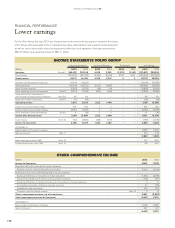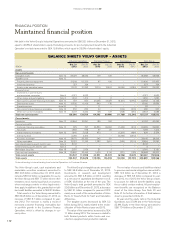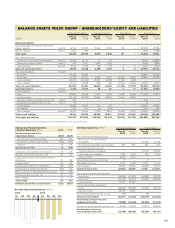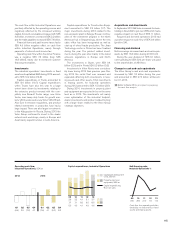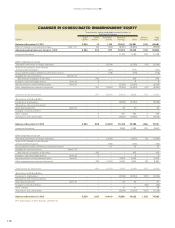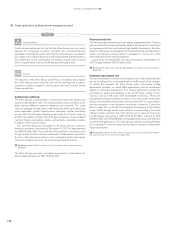Volvo 2013 Annual Report Download - page 122
Download and view the complete annual report
Please find page 122 of the 2013 Volvo annual report below. You can navigate through the pages in the report by either clicking on the pages listed below, or by using the keyword search tool below to find specific information within the annual report.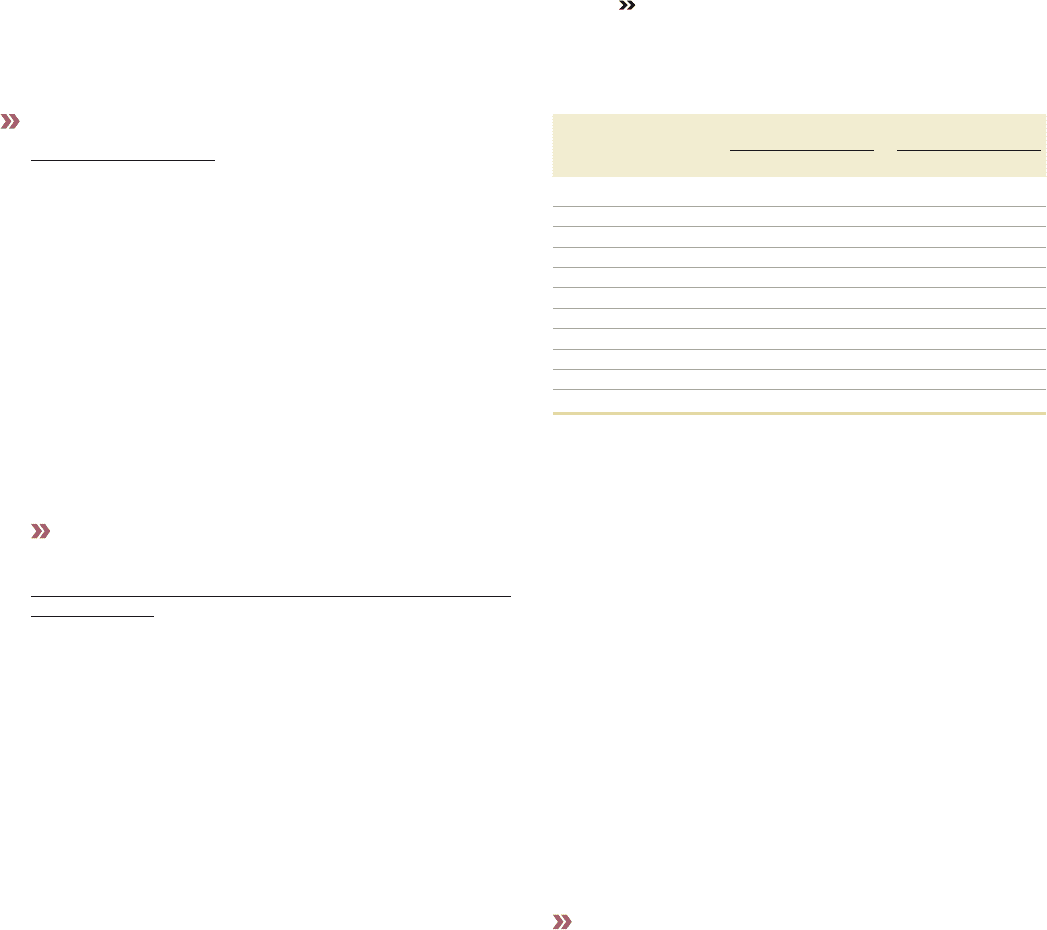
Consolidated fi nancial statements
Principles for consolidation
The consolidated fi nancial statements are as from January 2013 pre-
pared in accordance with the principles set forth in IFRS 10 Consolidated
Financial Statements. Accordingly, intra-group transactions and gains on
transactions with joint ventures and associated companies are eliminated.
The consolidated fi nancial statements comprise the Parent Company, sub-
sidiaries, joint ventures and associated companies.
– Subsidiaries are defi ned as entities that are controlled by the Volvo Group.
– Joint ventures refer to joint arrangements whereby the Volvo Group to -
gether with one or more parties that have joint control, have rights to the
net assets of the arrangements. Joint ventures are as from January 1,
2013 recognized using the equity method of consolidation. Comparative
fi gures for 2012 have been restated.
– Associated companies are companies in which Volvo Group has a sig-
nifi cant infl uence, which is normally when Volvo Group’s holding of
shares correspond to at least 20% but less than 50% of the voting
rights. Holdings in associated companies are recognized in accordance
with the equity method.
Read more about how the changes in accounting principles for joint ventures
have affected the Volvo Group’s fi nancial reports in Note 31.
Translation to Swedish kronor when consolidating companies are using
foreign currencies
AB Volvo’s functional currency is Swedish krona (SEK). The functional
currency of each Volvo Group company is determined based on the pri-
mary economic environment in which it operates. The primary economic
environment is normally the one in which the company primarily generates
and expends cash. In most cases, the functional currency is the currency
of the country where the company is located. AB Volvo’s and the Volvo
Group’s presentation currency is SEK. In preparing the consolidated fi nan-
cial statements, items in the income statements of foreign subsidiaries
(except for subsidiaries in hyperinfl ationary economies) are translated to SEK
using monthly average exchange rates. Balance-sheet items are trans-
lated into SEK using exchange rates at year-end (closing rate). Exchange
differences arising, are recognized in other comprehensive income and
accumulated in equity.
The accumulated translation differencies related to a certain subsidi-
ary, joint venture or associated company are reversed to the income state-
ment as a part of the gain/loss arising from disposal of such a company
or repayment of capital contribution from such a company.
Receivables and liabilities in foreign currency
Receivables and liabilities in currencies other than the functional currency
(foreign currencies) are translated to the functional currency using the
closing rate. Translation differences on operating assets and liabilities are
recognized in operating income, while translation differences arising in
fi nancial assets and liabilities are recognized in fi nancial income and
expenses. Financial assets and liabilities are defi ned as items included in
the net fi nancial position of the Volvo Group (see Defi nitions at the end of
this report). Derivative fi nancial instruments used for hedging of exchange
and interest risks are recognized at fair value. Gains on exchange rates
are recognized as receivables and losses on exchange rates are recog-
nized as liabilities. Depending on the lifetime of the fi nancial instrument,
the item is recognized as current or non-current in the balance sheet.
Ex change rate differences on loans and other fi nancial instruments in
foreign currency, which are used to hedge net assets in foreign subsidiaries
and associated companies, are offset against translation differences in the
shareholders’ equity of the respective companies. Exchange-rate gains and
losses on assets and liabilities in foreign currencies, both on payments dur-
ing the year and on measurements at year-end, impact profi t or loss in the
year in which they are incurred. The more important exchange rates applied
in the consolidated fi nancial statements are shown in the table.
Exchange rates Average rate Closing rate
as of Dec 31
Country Currency 2013 2012 2013 2012
Australia AUD 6.3046 7.0183 5.7592 6.7655
Brazil BRL 3.0308 3.4837 2.7821 3.1885
Euro Zone EUR 8.6586 8.7145 8.9523 8.6259
Japan JPY 0.0669 0.0851 0.0619 0.0757
Canada CAD 6.3294 6.7827 6.0755 6.5536
China CNY 1.0573 1.0738 1.0732 1.0456
Norway NOK 1.1105 1.1651 1.0590 1.1682
Great Britain GBP 10.1926 10.7402 10.7392 10.4977
South Africa ZAR 0.6773 0.8275 0.6213 0.7661
South Korea KRW 0.0060 0.0060 0.0062 0.0061
United States USD 6.5153 6.7767 6.5097 6.5169
New accounting principles for 2013
As from January 1, 2013 the Volvo Group applies the following new account-
ing standards:
IFRS 10 Consolidated Financial Statements, IFRS 11 Joint Arrangements,
IFRS 12 Disclosure of Interests in Other Entities, amendments to IFRS 10,
IFRS 11 and IFRS 12, IFRS 13 Fair value Measurement, IAS 28 Investments
in Associates and joint ventures (revised 2011), amendments to IAS 1 Pres-
entation of Financial Statements, amendments to IAS 36 Impairment of
Assets, amendments to IFRS 7 Financial instruments: Disclosures and
IAS 19 Employee Benefi ts (revised 2011). The Volvo Group has also as from
January 1, 2013 changed the presentation regarding hedging effects on fi rm
fl ows to be included in the fi nance net, these were previously reported
within operating income. However hedging effects on fi rm fl ows from spe-
cifi c orders are still recognized in the operating income.
The major accounting changes refer to recognition of investments in
joint ventures in accordance with IFRS 11 and IAS 28 (revised), that the
Volvo Group ceases to account for defi ned pension liabilities using the so
called corridor method in accordance with IAS 19 (revised) and that the
presentation of hedging effects on commercial fl ows are changed to be
included in the fi nance net. The new accounting principles have been
applied retrospectively and comparative numbers for 2012, except for
cash-fl ow information, are restated and do not correspond to the numbers
presented in the Volvo Group Annual Report 2012.
Read more about the restatement and how IFRS 11 and IAS 28 (revised),
IAS19 (revised) and the changes in presentation of hedging have affected the
Volvo Group’s fi nancial reports in Note 31.
IFRS 10 Consolidated Financial Statements
IFRS 10 replaces the consolidation instructions in IAS 27 Consolidated
and Separate Financial Statements and SIC – 12 Consolidation – Special
Purpose Entities and introduce one basis for consolidation, which is control.
If the following three criteria are fulfi lled control is obtained (i) power of
the investee (ii) exposure, or rights, to variable returns from its involvement
with the investee, and (iii) the ability to use power over the investee to
affect the amount of the return. IFRS 10 has not had any signifi cant
impact on the consolidation of other companies of which the Volvo Group
has ownership or is involved.
IFRS 12 Disclosure of Interests in Other Entities
IFRS 12 requires more detailed disclosures on subsidiaries, joint arrange-
ments, associates and any unconsolidated structured entities in which the
company is involved. The disclosures in note 5 in the Volvo Group’s annual
report 2013 have to some extent increased due to IFRS 12. The disclosures
related to minority interests have also increased and are shown in note 11.
118
FINANCIAL INFORMATION 2013
118


